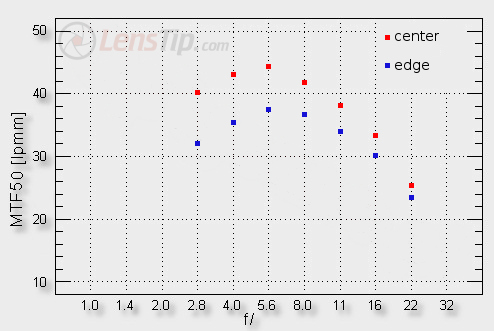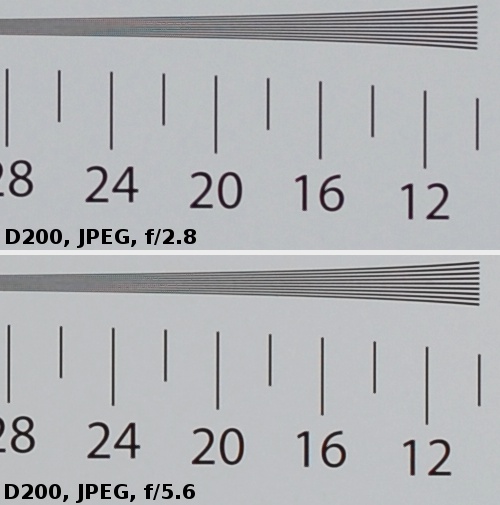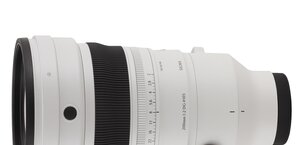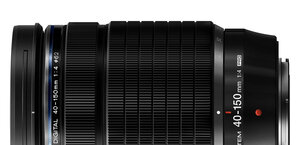Nikon Nikkor AF-S DX Micro 40 mm f/2.8G
4. Image resolution
I would like to explain something here. When cameras equipped with an APS-C/DX sensor with 16 million pixels, produced by Sony, appeared on the horizon for the first time I was really very happy. Using such cameras in the tests as the Pentax K-5, the Nikon D7000, the Sony A580, the SLT A55 or the NEX-5 made possible comparing directly the results of lenses from different systems tested on a detector with the same pixel density. If you add the fact that MTFs produced by the Canon 50D and the Olympus E-3 (so cameras also used by us in optics testing) are very similar to the results showed by cameras boasting a 16 Mpix CMOS produced by Sony, the situation seems to be perfect. Unfortunately it is only the first impression - when you go into detail, the problems start increasing swiftly.
Firstly the Sony A580 is not produced anymore; secondly, it doesn’t have the function of initial mirror lifting so you can test only lenses with focal lengths shorter than 50 mm on it. The NEX and SLT devices from Sony unfortunately have very big differences between horizontal and vertical MTF50 function values (stemming most likely from different strength of AA filter), so they are not fit for optics tests. The Nikon D7000 performs well compared to that. Unfortunately it doesn’t mean there are no other problems. First there have been a lot of reports, circulating on the Internet, that some specimen of that camera don’t perform well with fast lenses. Secondly the results of our D7000 test showed that the sensor of that camera fares noticeably worse than that of, say, the Pentax K-5.
Please Support UsIf you enjoy our reviews and articles, and you want us to continue our work please, support our website by donating through PayPal. The funds are going to be used for paying our editorial team, renting servers, and equipping our testing studio; only that way we will be able to continue providing you interesting content for free. |
- - - - - - - - - - - - - - - - - - - - - - - - - - - - - - - - - - - - - - - - - - - - - - - -
If you want to test optics well, the performance of your testing body must be beyond a shadow of doubt. That’s why we made a decision to use the D200 Nikon camera in our DX lenses tests, a reliable instrument because it has been well-tired many times in different conditions. Although it is a quite elderly model from our perspective it would be difficult to fault. At low speeds (and such are used in optics tests) it still performs admirably. Maximum MTFs, generated by that camera, are only less than 10% lower than those of 15-16 megapixel sensors from the K-5 or 50D – even the best lenses can be tested on it. What’s more, the D200 do not interfere into JPEG files in a significant way and doesn’t remove chromatic aberration, like Nikon reflex cameras, produced later which allows to asses the real optics capabilities better while looking at sample shots. Apart from that the autofocus of that camera is very good even according to contemporary standards and it doesn’t arouse such controversies as that of the D700.
That’s why our Nikon D200 is not going to retire any time soon and we are still waiting for the next launches of Nikon reflex cameras. When the successor of the Nikon D300s appears with a 16-megapixel detector we will consider buying it for test optics. I am afraid, though, that we will find 24 million pixels in it and we will have to forget about performing most of our tests based on 15-16 mpix class sensors.
Let’s return to the main hero of our test and see how it fares in the frame centre and on the edge.

As you see, in the frame centre, even at the maximum relative aperture, we get splendid results because the lens reaches 40 lpmm there. The highest values, on the level of 43-44 lpmm, we see for f/4.0-5.6 apertures. Although these are really very good, you can complain a bit – still they are about 10% lower than the record results achieved on the Nikon D200 sensor and, after all, exactly those well-corrected and not particularly fast macro lenses have often MTFs close to records. It’s enough to remind here the very old Nikkor AF Micro 60 mm f/3.8D which, on D200, got to 46 lpmm. What’s more, the direct rival of the Nikkor 2.8/40, the Tokina AT-X M35 PRO DX 35 MM F/2.8, could reach values on the level of 45 lpmm and tested on a less pixel-packed sensor of the Canon 20D to boot. The tested lens, although newer than its direct competitors, doesn’t fare better than them. There are no reservations concerning the performance of the lens on the edge of the frame. Even at the maximum relative aperture the decency level is exceeded slightly and on further stopping down we see the image quality increasing to good and very good level.
Below we present out testing chart crops, saved in the JPEG format, which were recorded along RAW files, used for the analysis posted above.
 |






